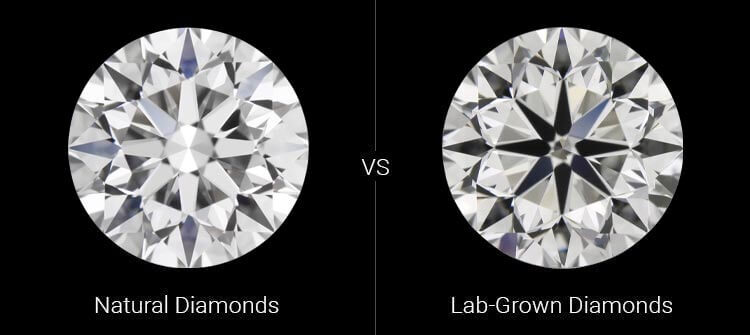Creation Processes: Lab Diamonds vs Natural Diamonds
One of the key differences in the debate of diamantes de laboratorio vs diamantes naturales lies in their creation processes.
- Lab Diamonds: Lab diamonds are created in controlled environments using two main methods: High Pressure High Temperature (HPHT) and Chemical Vapor Deposition (CVD). The HPHT method replicates the extreme conditions of the Earth’s mantle, while CVD involves depositing carbon atoms onto a substrate. Both methods produce diamonds that are chemically and physically identical to natural diamonds.
- Natural Diamonds: Natural diamonds form over millions of years deep within the Earth’s mantle under high pressure and temperature conditions. This geological process results in diamonds with unique characteristics influenced by their natural formation environment. The formation time for natural diamonds contrasts sharply with the relatively short period required to create lab diamonds.
Physical Properties: Lab Diamonds vs Natural Diamonds
In terms of physical properties, lab diamonds vs natural diamonds exhibit remarkable similarities.
- Lab Diamonds: Lab diamonds share the same crystal structure as natural diamonds, consisting of carbon atoms arranged in a tetrahedral lattice. This structure gives lab diamonds their hardness, brilliance, and fire, which are indistinguishable from natural diamonds. Lab diamonds can be produced with varying levels of clarity and color, similar to natural diamonds.
- Natural Diamonds: Natural diamonds also have a crystalline structure of carbon atoms, which contributes to their renowned hardness and brilliance. The physical properties of natural diamonds can be influenced by inclusions and impurities that occurred during their formation. These natural imperfections are unique to each diamond and can affect its overall appearance and value.
Cost Considerations: Lab Diamonds vs Natural Diamonds
When comparing lab diamonds vs natural diamonds, cost is a significant factor.
- Lab Diamonds: Lab diamonds are generally more affordable than natural diamonds. The controlled creation process and the absence of mining costs contribute to their lower price. Consumers can often find lab diamonds that offer the same quality and characteristics as natural diamonds but at a fraction of the cost. This cost-effectiveness makes lab diamonds an attractive option for those seeking high-quality gemstones without the premium price tag.
- Natural Diamonds: Natural diamonds typically come with a higher price due to their rarity and the extensive mining process required to extract them. The cost of natural diamonds can vary significantly based on factors such as carat weight, color, clarity, and cut. The market value of natural diamonds is influenced by their perceived rarity and the costs associated with their extraction and distribution.
Ethical and Environmental Impact: Lab Diamonds vs Natural Diamonds
Ethical and environmental considerations are crucial in the discussion of lab diamonds vs natural diamonds.
- Lab Diamonds: Lab diamonds are considered more ethical and environmentally friendly compared to natural diamonds. They are produced in controlled environments, which eliminates concerns related to conflict diamonds and environmental damage caused by mining. Lab diamonds offer a responsible choice for consumers who prioritize ethical sourcing and sustainability.
- Natural Diamonds: The extraction of natural diamonds can have significant environmental and ethical implications. Traditional diamond mining can lead to habitat destruction, soil erosion, and other environmental impacts. Additionally, concerns about conflict diamonds, which are mined in war zones and fund violence, have led to increased scrutiny and efforts to ensure ethical sourcing practices.
Market Trends: Lab Diamonds vs Natural Diamonds
The market trends for lab diamonds vs natural diamonds reflect shifting consumer preferences.
- Lab Diamonds: The popularity of lab diamonds is growing as consumers become more aware of their ethical and environmental benefits. Advances in technology and the increasing availability of lab diamonds have made them a viable alternative to natural diamonds. The market for lab diamonds continues to expand, with more jewelry designers and retailers offering these stones.
- Natural Diamonds: Despite the rise of lab diamonds, natural diamonds continue to hold a significant place in the market. Many consumers still value the traditional allure and perceived rarity of natural diamonds. The natural diamond market remains robust, with ongoing efforts to address ethical concerns and promote responsible sourcing practices.
Conclusion
The comparison of lab diamonds vs natural diamonds highlights key differences and similarities that can influence your choice. Lab diamonds offer a cost-effective, ethical, and environmentally friendly alternative to natural diamonds, with comparable physical properties and aesthetic appeal. On the other hand, natural diamonds hold traditional value and rarity, despite concerns about their environmental and ethical impact. Understanding these factors can help you make an informed decision based on your preferences and values.

